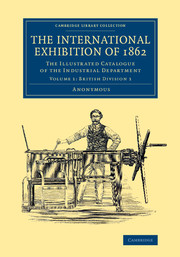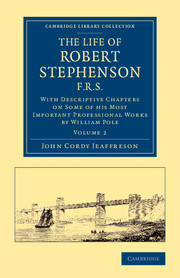Refine search
Actions for selected content:
13588 results in History of science and technology
Ted R. Anderson, The Life of David Lack: Father of Evolutionary Ecology. Oxford: Oxford University Press, 2013. Pp. x+246. ISBN 978-0-992264-2. £37.50 (hardback).
-
- Journal:
- The British Journal for the History of Science / Volume 47 / Issue 4 / December 2014
- Published online by Cambridge University Press:
- 07 November 2014, pp. 753-754
- Print publication:
- December 2014
-
- Article
- Export citation
Annette Lykknes, Donald L. Opitz and Brigitte van Tiggelen (eds.), For Better or for Worse? Collaborative Couples in the Sciences. Heidelberg, New York and London: Birkhäuser, 2012. Pp. xiv+319. ISBN 978-3-0348-0285-7. €23.53 (hardback).
-
- Journal:
- The British Journal for the History of Science / Volume 47 / Issue 4 / December 2014
- Published online by Cambridge University Press:
- 07 November 2014, pp. 749-750
- Print publication:
- December 2014
-
- Article
- Export citation
Louise Miskell, Meeting Places: Scientific Congresses and Urban Identity in Victorian Britain. Farnham: Ashgate, 2013. Pp. xi+192. ISBN 978-1-4094-5237-9. £60.00 (hardback).
-
- Journal:
- The British Journal for the History of Science / Volume 47 / Issue 4 / December 2014
- Published online by Cambridge University Press:
- 07 November 2014, pp. 737-738
- Print publication:
- December 2014
-
- Article
- Export citation
Books reviewed
-
- Journal:
- The British Journal for the History of Science / Volume 47 / Issue 4 / December 2014
- Published online by Cambridge University Press:
- 07 November 2014, pp. 769-771
- Print publication:
- December 2014
-
- Article
- Export citation
Sevan G. Terzian, Science Education and Citizenship: Fairs, Clubs, and Talent Searches for American Youth, 1918–1958. New York: Palgrave Macmillan, 2013. Pp. xv+235. ISBN 978-1-137-03186-0. £55.00 (hardback).
-
- Journal:
- The British Journal for the History of Science / Volume 47 / Issue 4 / December 2014
- Published online by Cambridge University Press:
- 07 November 2014, pp. 752-753
- Print publication:
- December 2014
-
- Article
- Export citation
Books received
-
- Journal:
- The British Journal for the History of Science / Volume 47 / Issue 4 / December 2014
- Published online by Cambridge University Press:
- 07 November 2014, pp. 763-766
- Print publication:
- December 2014
-
- Article
- Export citation
Alison Walker, Arthur MacGregor and Michael Hunter (eds.), From Books to Bezoars: Sir Hans Sloane and His Collections. London: The British Library, 2012. Pp. x+310. ISBN 978-0-7123-5880-4. £45.00 (hardback).
-
- Journal:
- The British Journal for the History of Science / Volume 47 / Issue 4 / December 2014
- Published online by Cambridge University Press:
- 07 November 2014, pp. 728-730
- Print publication:
- December 2014
-
- Article
- Export citation
John Krige, Angelina Long Callahan and Ashok Maharaj, NASA in the World: Fifty Years of International Collaboration in Space. New York: Palgrave Macmillan, 2013. Pp. xvii+353. ISBN 978-1-137-34092-4 . £22.00 (paperback).
-
- Journal:
- The British Journal for the History of Science / Volume 47 / Issue 4 / December 2014
- Published online by Cambridge University Press:
- 07 November 2014, pp. 757-759
- Print publication:
- December 2014
-
- Article
- Export citation
Anna Echterhölter, Schattengefechte: Genealogische Praktiken in Nachrufen auf Naturwissenschaftler (1710–1860). Göttingen: Wallstein, 2012. Pp. 365. ISBN 978-3-8353-1071-1. €39.90 (paperback). - Denise Phillips, Acolytes of Nature: Defining Natural Science in Germany 1770–1850. Chicago and London: The University of Chicago Press, 2012. Pp. 356. ISBN 0-226-66737-9. £29.99 (hardback).
-
- Journal:
- The British Journal for the History of Science / Volume 47 / Issue 4 / December 2014
- Published online by Cambridge University Press:
- 07 November 2014, pp. 734-735
- Print publication:
- December 2014
-
- Article
- Export citation
BJH volume 47 issue 4 Cover and Back matter
-
- Journal:
- The British Journal for the History of Science / Volume 47 / Issue 4 / December 2014
- Published online by Cambridge University Press:
- 07 November 2014, pp. b1-b7
- Print publication:
- December 2014
-
- Article
-
- You have access
- Export citation
Scott L. Montgomery, Does Science Need a Global Language?Chicago and London: The University of Chicago Press, 2013. Pp. xiii+226. ISBN 978-0-226-53503-6. £16.00 (hardback).
-
- Journal:
- The British Journal for the History of Science / Volume 47 / Issue 4 / December 2014
- Published online by Cambridge University Press:
- 07 November 2014, pp. 760-762
- Print publication:
- December 2014
-
- Article
- Export citation
Tatiana Holway, The Flower of Empire: An Amazonian Water Lily, the Quest to Make It Bloom, and the World It Created. Oxford: Oxford University Press, 2013. Pp. xiv+306. ISBN 978-0-19-537389-9. £18.99 (hardback).
-
- Journal:
- The British Journal for the History of Science / Volume 47 / Issue 4 / December 2014
- Published online by Cambridge University Press:
- 07 November 2014, pp. 738-740
- Print publication:
- December 2014
-
- Article
- Export citation
Renato G. Mazzolini and Hans-Jörg Rheinberger (eds.), Differing Routes to Stem Cell Research: Germany and Italy. Bologna and Berlin: Il Mulino/Duncker and Humblot, 2012. Pp. 271. ISBN 978-3-428-13849-4. €22.00 (paperback).
-
- Journal:
- The British Journal for the History of Science / Volume 47 / Issue 4 / December 2014
- Published online by Cambridge University Press:
- 07 November 2014, pp. 759-760
- Print publication:
- December 2014
-
- Article
- Export citation
Alexandra Cook, Jean-Jacques Rousseau and Botany: The Salutary Science. Oxford: Voltaire Foundation, 2012. Pp. xxi+436. ISBN 978-0-729410557. £70.00 (paperback).
-
- Journal:
- The British Journal for the History of Science / Volume 47 / Issue 4 / December 2014
- Published online by Cambridge University Press:
- 07 November 2014, pp. 730-731
- Print publication:
- December 2014
-
- Article
- Export citation
Alison Winter, Memory: Fragments of a Modern History. Chicago and London: The University of Chicago Press, 2012. Pp. x+319. ISBN 978-0-226-90258-6. £21.00 (hardback).
-
- Journal:
- The British Journal for the History of Science / Volume 47 / Issue 4 / December 2014
- Published online by Cambridge University Press:
- 07 November 2014, pp. 750-751
- Print publication:
- December 2014
-
- Article
- Export citation
Mitchell G. Ash and Jan Surman (eds.), The Nationalization of Scientific Knowledge in the Habsburg Empire, 1848–1918. Basingstoke: Palgrave Macmillan, 2012. Pp. xi+258. ISBN 978-0-230-28987-1. £50.00 (hardback).
-
- Journal:
- The British Journal for the History of Science / Volume 47 / Issue 4 / December 2014
- Published online by Cambridge University Press:
- 07 November 2014, pp. 742-743
- Print publication:
- December 2014
-
- Article
- Export citation
Jean-Paul Gaudillière and Volker Hess (eds.), Ways of Regulating Drugs in the 19th and 20th Centuries. Basingstoke: Palgrave Macmillan, 2013. Pp. xiv+327. ISBN 978-0-230-30196-2. £60.00 (hardback).
-
- Journal:
- The British Journal for the History of Science / Volume 47 / Issue 4 / December 2014
- Published online by Cambridge University Press:
- 07 November 2014, pp. 745-746
- Print publication:
- December 2014
-
- Article
- Export citation
BJH volume 47 issue 4 Cover and Front matter
-
- Journal:
- The British Journal for the History of Science / Volume 47 / Issue 4 / December 2014
- Published online by Cambridge University Press:
- 07 November 2014, pp. f1-f2
- Print publication:
- December 2014
-
- Article
-
- You have access
- Export citation

The International Exhibition of 1862
- The Illustrated Catalogue of the Industrial Department
-
- Published online:
- 05 November 2014
- Print publication:
- 17 April 2014

The Life of Robert Stephenson, F.R.S.
- With Descriptive Chapters on Some of his Most Important Professional Works
-
- Published online:
- 05 November 2014
- Print publication:
- 20 March 2014
- First published in:
- 1864
